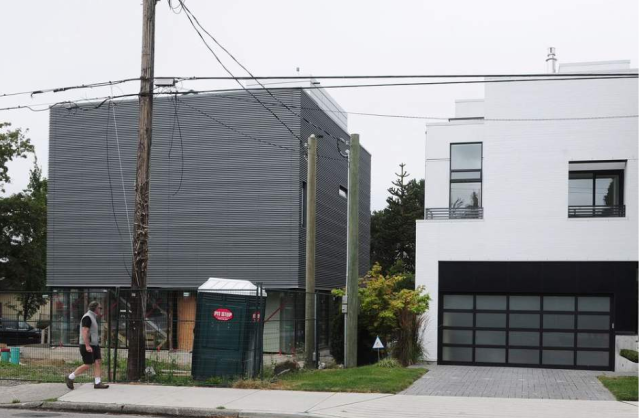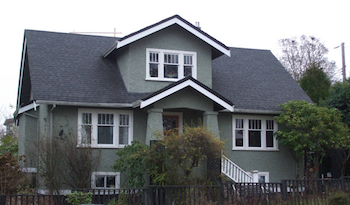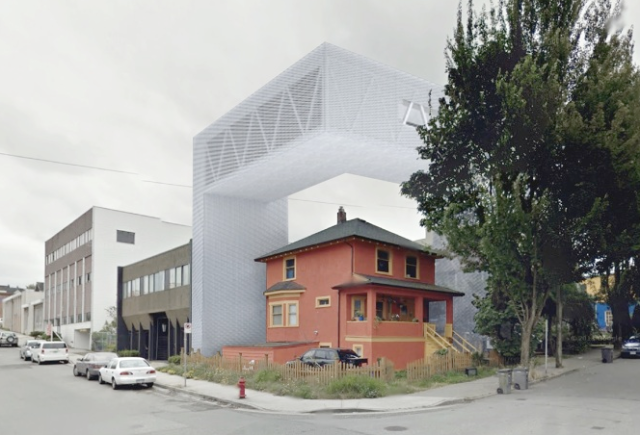
Some Vancouverites are upset over the house to the left in the photo above. “Vancouver’s Most Hideous Urban Design for 2016: Why residents are up in arms over this house,” reads the headline in The National Post.
So why are residents up in arms over this house? Let me guess. There is a clue in the headline: it is Vancouver’s “most hideous urban design for 2016.” Talk about a headline belaboring the obvious! That black box has replaced a house of very pleasant traditional lines, depicted below left. Although the house above on the left is certainly uglier than the house on the right, the latter, which copies the past in the Corbusian manner, is no candidate for the charmer of the year award. Why wasn’t residential Vancouver just as upset by that house as it supposedly is by its glowering new neighbor?

Original 3691 Point Grey Rd. (theprovince.com)
The architect, Tony Robins, proposes another, um, house in Vancouver that has raised eyebrows. Pictured at the end of this post, it is considered a “heritage infill” project, not completed (or even really planned, perhaps). Hasn’t anyone noted its resemblance to Rem Koolhaas’s “Big Pants” building for China’s CCTV in Beijing? Unlike Big Pants, which stomps with metaphorical rage upon the Chinese people, Robins’s proposed building almost literally stomps on, or at least threatens to collapse upon, the old house above which it hovers. Who would want to live there? Why wasn’t Vancouver up in arms over this proposal? Perhaps because it, like its neighbors, is apparently a commercial enterprise? So what?
The National Post’s writer, Cheryl Chan, talked to the neighbors.
A neighbour who lives across the street was befuddled by the design. “Where are the windows?” she asked. “Is that black the end result or are they going to stick something on the front?”
Are there no courts of law to resolve this sort of dispute? Does the neighbor quoted above, who apparently understands the threat to her own house’s value, have no recourse? The National Post story continues, quoting a historian’s description of housing trends.
Michael Kluckner described the house as “unneighbourly” but par for the course — the ultimate expression of our society’s evolution from a front-porch culture to a courtyard culture.
A century ago, Vancouver houses looked outward, their windows as eyes on the street with front porches that allowed for interaction with neighbours, said Kluckner. But throughout the decades, “there was a turning inward that has accelerated.”
Modern homes now usually present “an almost blank face on the street,” with drawn windows and an expansion of the backyard as a private recreational space. “You realize how much the design of a house … has the ability to connect with people and how much of that has disappeared,” he said.
Why are people in neighborhoods throughout this great continent of ours, or for that matter the world, not up in arms about this kind of architecture wherever and whenever it is built? It could be that they are, but feel helpless to do anything about it. Architecture has become a powerful cult, having planted roots since 1950 in the cultural establishment in spite of the regrets felt and sometimes even voiced by anybody with a mind. Eventually, the world will undertake an intervention.

Another proposal, possibly an office, by Tony Robins. (aarobins.com)



Housing architecture is imitating life – in these frightening times when we watch atrocities play out all over the world, and the events come closer to home with stateside terrorism, home invasions, crime, etc., it is an inevitable thing to see housing less “friendly” on the outside and more “cocooned” on the inside – internal courtyards, secure nesting, a sense of security and fortress – a drawing up of the drawbridge to the cold, cruel world on the outside. This house could be enhanced by the addition of some beautiful swaying wild grasses, ferns and bamboo….and some uplighting…sigh….troubled times we “LIVE IN”.
LikeLike
Interesting point, Nancy. It may be the coldness of the housing and other buildings in our lives and environments that creates the conditions in which the perception of danger is so great and the reaction to it so inimical to friendliness or love.
LikeLike
Perhaps, but as you suggest, there’s no law requiring it to be ugly.
LikeLike
Several years ago Cele and I were in North Vancouver . There we met a mutual friend who had recently sold his Tudor house with a Shakespearian garden, a place visited by garden tours. The house was a perfect reproduction of what one might see at Stratford =On-Avon. The trees on the property were planted forty years before by the owner and cared for unstintingly. When his wife died, he decided to sell and move to a condo. Dozens of possible buyers were awed by the property and offered more than the asking price, but the owner wanted a buyer who appreciated the exceptionality of the place. The prospective owners showed overwhelming admiration for what the owner had accomplished and made the winning bid. Six months later, former neighbors called our friend to tell him something “untoward” was happening on the property. He drove us up to see what became of his 40 years of meticulous care and taste: The house was torn down, the gardens and trees were removed and a house like the one to the right of your “Ugliest house” was in the process of being built. >
LikeLike
There are laws against fraud. Would they apply here? Might the new owner have suffered some sort of financial reverse, swaying him against preserving the beauty of what he had purchased? Who knows, but neither dishonesty per se, nor poor taste, is against the law.
LikeLike
Unfortunately, nothing regarding changes to the property is binding on the buyer after closing. The only way to preserve your property is to have deed restrictions added to the deed, which can be done easily with almost a variety of provisions. In some instances (if the property is designated historic) certain easements may be added to the deed. In some locales sellers are fearful that these might make the property difficult to sell, but in the case described , and most of Vancouver, finding buyers is not an issue.
LikeLike
I am going to wager that “a century ago” this was a quiet, lazy street. If you go to Google Maps you can see that this lot is at the corner of a crazy intersection. Although the design could certainly have been friendlier, I can’t blame the owners for wanting to block off the ugly traffic and noise that must go on constantly right in front of their home.
LikeLike